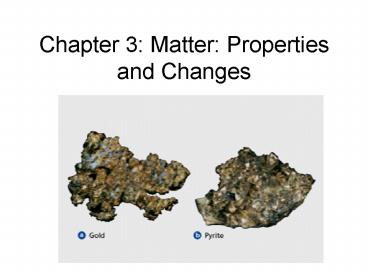Chapter 3: Matter: Properties and Changes - PowerPoint PPT Presentation
1 / 38
Title:
Chapter 3: Matter: Properties and Changes
Description:
A 3.5 kg iron shovel is left outside through the winter. The shovel now orange with rust, is rediscovered in the spring. Its mass is 3.7 kg. ... – PowerPoint PPT presentation
Number of Views:157
Avg rating:3.0/5.0
Title: Chapter 3: Matter: Properties and Changes
1
Chapter 3 Matter Properties and Changes
2
Pure Substances
- Uniform unchanging composition
- NaCl, Water, Tap Water, Sea Water, HCl, Coke
3
Describing Pure Substances
- Physical Properties
- Observed without changing the composition of a
substance - Density, color, smell, boiling point, melting
point, freezing point, luster, odor, hardness
4
Extensive and Intensive Properties
- Extensive dependent on the amount of a
substance - mass
- Intensive independent
- density
5
Chemical Properties
- The ability of matter to combine with or change
into one or more substance - Inability also
6
Observing Chemical and Physical Properties
7
Always State the Conditions Temperature and
Pressure
Water
Liquid Not Reactive D 1.00 g/cm3
Gas Reactive D .0006 g/cm3
Which are examples of chemical properties and
physical properties?
8
Kinetic Energy Energy of Particle Motion
- Increasing KE
- Solid ? liquid ? Gas
- Temperature measures the intensity of heat due
to the average KE - ??? Temp ? KE
- Heat measures the total quantity of KE
- Transfer of energy from higher temp to lower temp
9
Temperature vs. Heat
- Which has more heat?
- Which has a higher temperature?
10
States of Matter
Definite Shape and Volume (Not compressible),
11
States of Matter
Indefinite Shape, and Definite Volume (Not
Compressible)
12
States of Matter
Particles are far apart
Indefinite Shape and Indefinite Volume
(Compressible)
13
Vapor vs. Gas
- Vapor a gaseous state of a substance that is a
solid or liquid at room temperature
NH3 - Ammonia
CO2 Dry Ice
H2O - Steam
14
States of Matter
Plasma ionized gas, one or more electrons are
lost
15
Physical Changes
- The altering of a substance w/o changing the
composition
16
Heating and Cooling Curve
Gas and Liquid in Equilibrium
Solid and Liquid in Equilibrium
Super Cooling cooling occurs so rapidly the
normal solid structure cannot form
17
Heating and Cooling Curve
H2O (s) energy ? H2O (l) (endothermic) H2O (l)
? H2O (s) energy (exothermic) H2O (l) energy
? H2O (g) (endothermic) H2O (g) ? H2O (l)
energy (exothermic)
Hydrogen bonds are disrupted during melting and
set in place during freezing
18
Phase Diagram for Water
19
Chemical Change
- The change of substances into new substances
- Chemical Reaction
Fe(s) O2(g) ? Fe2O3(s)
rust
Reactants Products
20
Law of Conservation of Matter
- Mass is neither created nor destroyed in a
chemical reaction it is conserved - Mass reactants Mass products
- Antoine Lavoisier (1743-1794)
21
Applying the Law of Conservation of Matter
A 3.5 kg iron shovel is left outside through the
winter. The shovel now orange with rust, is
rediscovered in the spring. Its mass is 3.7 kg.
How much oxygen combined with the iron?
4Fe (s) 3O2 (g) ? 2Fe2O3 (s)
22
Sn (s) 4HCl (aq) ? SnCl4 (s) 2H2 (g)
When 5.0 g of tin reacts with hydrochloric acid,
the mass of the products, tin chloride and
hydrogen totals 8.1 g. How many grams of
hydrochloric acid were used?
23
Mixtures
- Combo of 2 or more pure substances in which each
substance retains its individual chemical
properties - 1st lab salt, sand, water
- Air N2, O2, CO2 etc
24
Homogeneous vs. Heterogeneous
Uniform constant composition same state
Not uniform Distinct parts
Solutions May contain solids, liquids or gases
Alloys Solid mixtures, greater strength and
durability
25
(No Transcript)
26
Separating Mixtures
- Distillation
- Filtration
- Chromatography
- Centrifuges
- Gel Electrophoresis
27
Periodic Table
- Elements pure substances that cannot be
separated - 91 natural elements (black, red, blue)
- Others are made (purple)
- Periods
- Families (groups)
28
Compound
- Combination of two or more different elements
that are chemically combined - Can be broken apart
- Properties different from its component elements
- Ex. NaCl and Fe2O3
29
Molecule
- Combination of 2 or more atoms that are
covalently bonded - N2, O2, F2, CO2, NH3
30
Law of Definite Proportions
- Compounds always consist of the same elements in
the same proportions by mass
31
Law of Definite Proportions Cont.
32
Problems
A 134.5 g sample of aspirin is made up of 6.03 g
of hydrogen, 80.70 g of carbon and 47.77 g of
oxygen. What is the percent by mass of each
element in aspirin?
A 2.89 g sample of sulfur reacts with 5.72 g of
copper to form a black compound. What is the
percentage composition of the compound?
33
2S (s) O2 (g) ? 2SO (s)
4Al (s) 3O2 (g) ? 2Al2O3 (s)
34
Law of Multiple Proportions
- When different compounds are formed by a
combination of the same elements, different
masses of element combine with the same relative
mass of the other element in a ratio of small
whole numbers
35
(No Transcript)
36
(No Transcript)
37
(No Transcript)
38
What evidence on this graph supports the
following chemical equation? H2O (l) ? H2O (s)
energy (exothermic) Hint Revisit supercooling































